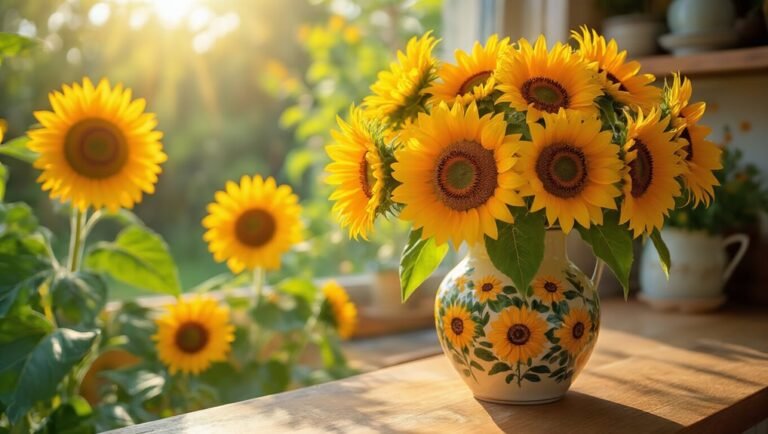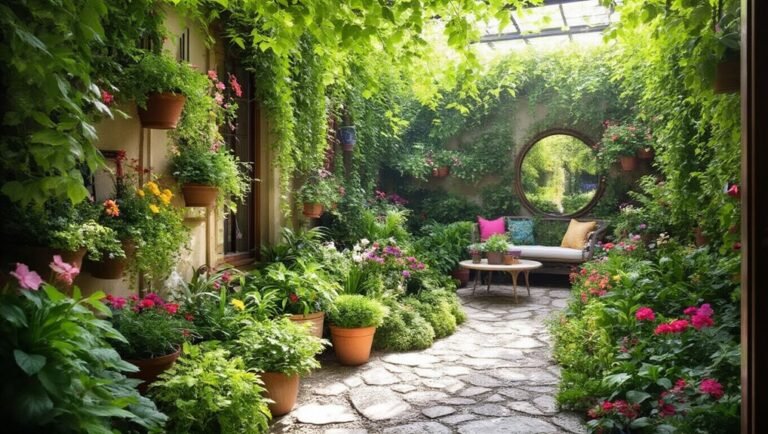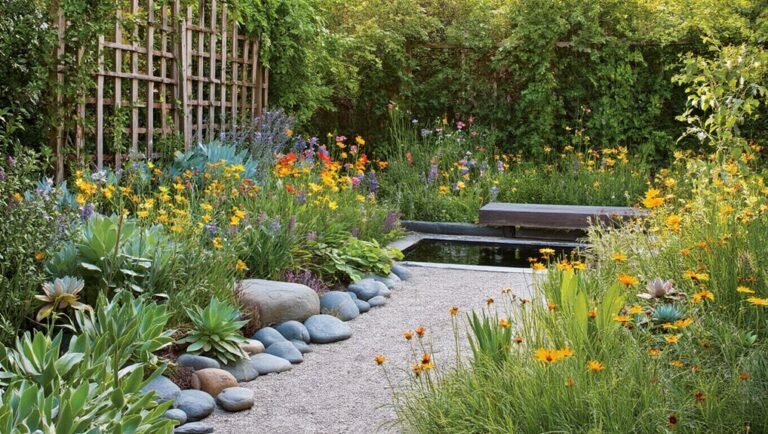For a vibrant backyard garden, position raised beds in a sunny spot with accessible pathways. Choose durable materials like wood or metal, and design your layout to maximize space by incorporating vertical gardening techniques. Pair plants wisely through companion planting to enhance growth and reduce pests. Don’t forget to add decorative elements and edible flowers for beauty and flavor. There’s so much more to explore for your garden’s success and appeal.
Key Takeaways
- Choose a sunny location with at least 6-8 hours of sunlight and easy access to water for raised beds and planters.
- Utilize companion planting by pairing beneficial plants, like tomatoes with basil, to enhance growth and deter pests.
- Incorporate vertical gardening techniques, such as trellises, to maximize space and add visual interest to your garden.
- Ensure soil health by regularly testing pH and nutrient levels, and amending with organic compost for optimal plant growth.
- Add decorative elements like colorful pots and whimsical garden ornaments to enhance the aesthetics of your raised beds and planters.
Choosing the Right Location for Your Raised Beds
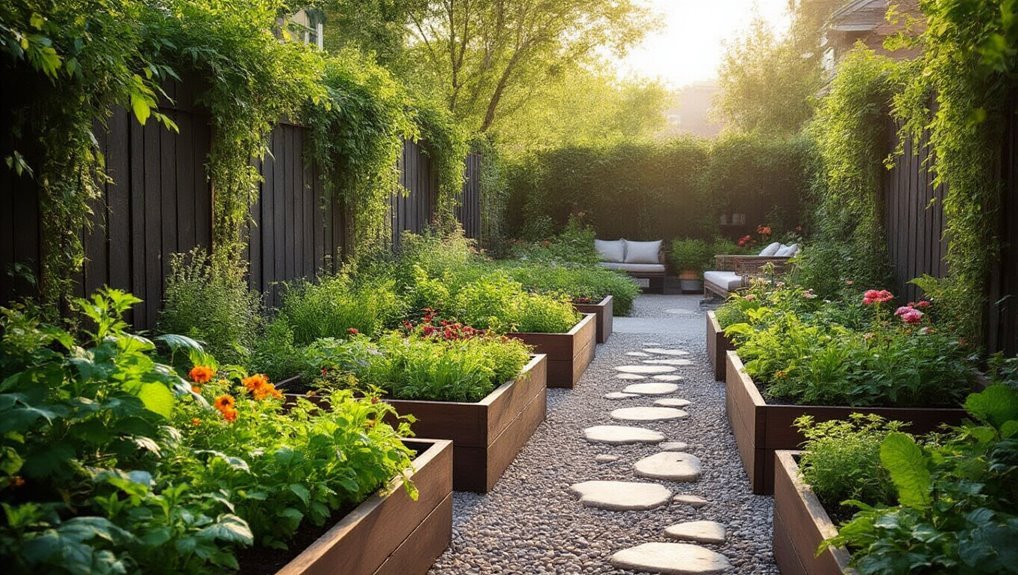
Where should you place your raised beds to get the most out of your backyard garden?
Start by selecting a spot that gets at least six to eight hours of sunlight daily. Sunlight is crucial for healthy plant growth.
Next, ensure your beds are positioned near a water source for easy irrigation. Avoid low-lying areas where water might pool, as this can harm your plants. Incorporating compost bins nearby can make it easier to enrich your raised beds with nutrient-rich organic matter.
Also, consider accessibility; you’ll want to reach your beds comfortably for planting, maintenance, and harvest. A location with good air circulation can help prevent disease, so steer clear of crowded spaces.
Lastly, think about wind exposure; a sheltered spot can protect tender plants from harsh conditions.
Choosing the right location is just as important as selecting quality raised garden beds, which can elevate your gardening success and make maintenance easier.
Choose wisely, and your garden will thrive!
Selecting the Best Materials for Raised Beds and Planters
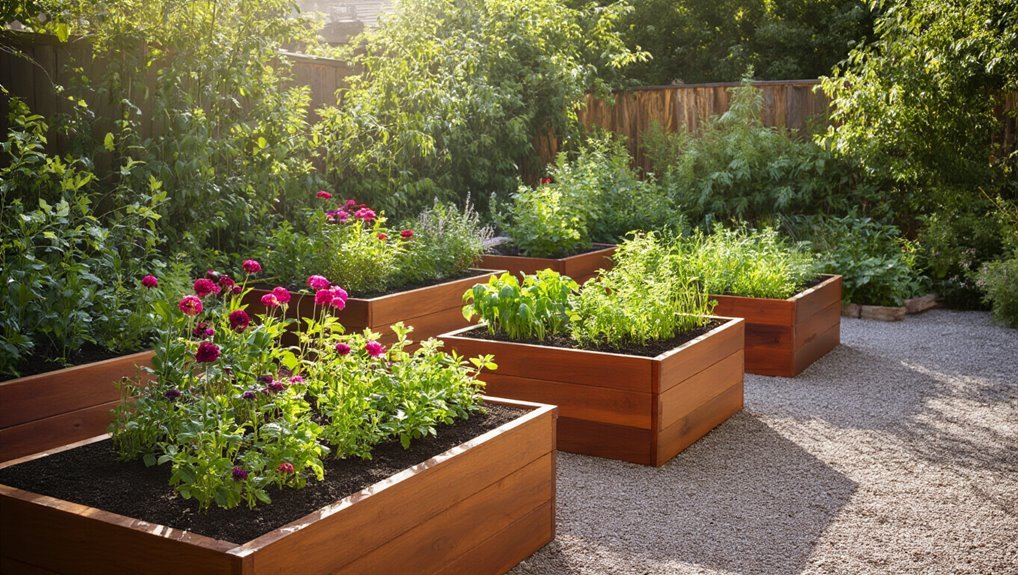
After you’ve chosen the ideal location for your raised beds, it’s time to think about the materials you’ll use. Selecting the right materials is crucial for durability and plant health. Here’s a quick comparison to help you decide:
| Material | Pros |
|---|---|
| Wood | Natural look, good insulation |
| Metal | Long-lasting, modern aesthetic |
| Composite | Eco-friendly, low maintenance |
Consider factors like cost, lifespan, and how they’ll fit into your garden’s aesthetic. For instance, untreated wood is great for a rustic feel, while metal offers a contemporary vibe. Always ensure whatever material you choose is safe for growing food. Your plants will thrive when you pick wisely! Adding essential gardening tool sets to your routine will also help you keep your raised beds and planters in top shape. Remember, when maintaining your garden, using pruning shears is essential for keeping your plants healthy and well-shaped.
Designing Your Garden Layout for Maximum Efficiency
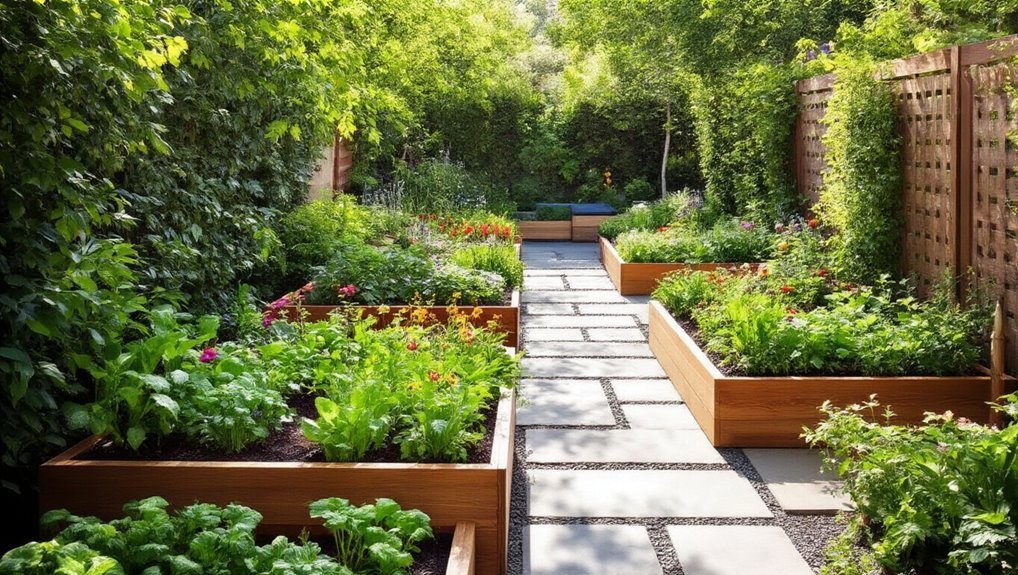
A well-planned garden layout can transform your outdoor space into a thriving oasis.
To maximize efficiency, consider the following tips:
- Sunlight Access: Position taller plants to the north or east, ensuring shorter ones get plenty of sunlight throughout the day. Proper placement allows you to optimize the use of garden trellis netting for climbing plants and vegetables.
- Accessible Pathways: Create clear, wide paths between beds for easy access and maintenance.
- Zoning: Group plants based on their water and sunlight needs, which simplifies care and reduces waste.
- Vertical Gardening: Utilize vertical space with trellises or wall planters to increase growing area without taking up too much ground space.
Adding beautiful trellises to your garden not only supports climbing plants but also enhances the visual appeal and structure of your outdoor space.
Companion Planting: Enhancing Growth and Flavor
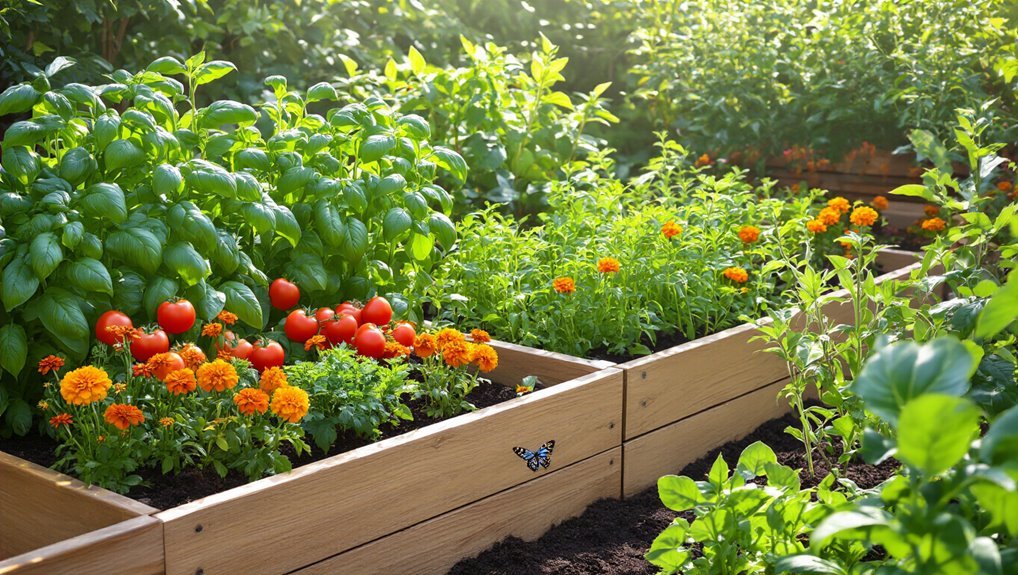
Companion planting can significantly enhance both the growth and flavor of your garden crops, as certain plants naturally support each other.
For instance, pairing tomatoes with basil can boost their flavor while deterring pests. Similarly, planting marigolds alongside vegetables can repel harmful insects, creating a healthier environment for your crops. If you want to simplify the process of growing herbs and vegetables together, consider starting with herb garden kits that include seeds and pots to make companion planting even easier.
You’ll also find that certain plants like beans fix nitrogen in the soil, benefiting neighboring plants like corn and squash. By strategically placing companions, you’ll maximize space and yield.
Don’t forget to consider flowering plants that attract beneficial pollinators, further improving your garden’s productivity.
For gardeners looking to get a head start on the season, using seed starting kits can help ensure strong, healthy seedlings for your companion planting combinations.
Experimenting with these combinations can lead to a thriving garden filled with vibrant flavors and robust growth. Happy planting!
Creative Planting Ideas for Vertical Gardening
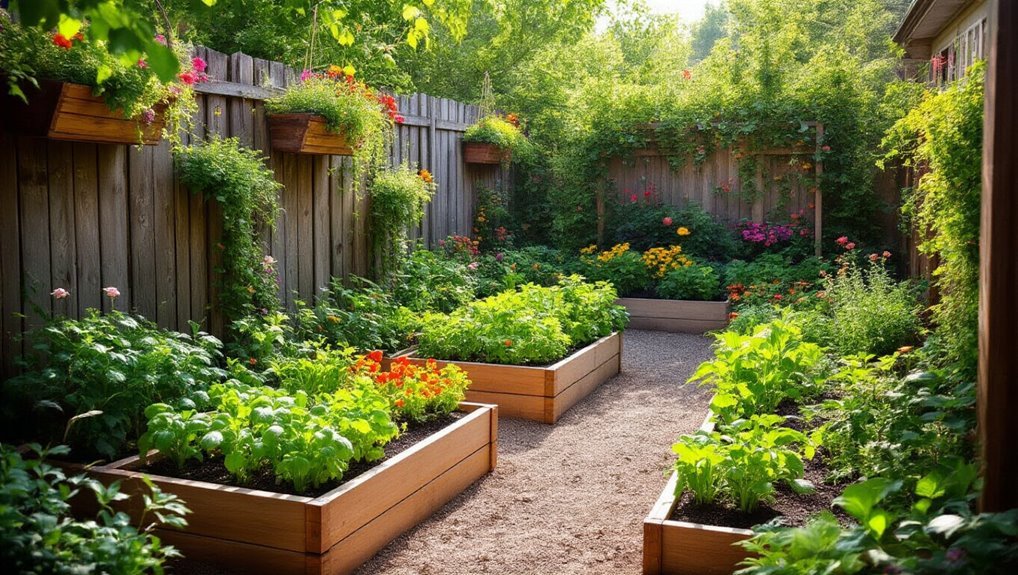
If you’re looking to maximize your gardening space, vertical gardening offers a creative solution that not only saves room but also adds visual interest to your backyard.
By utilizing walls, fences, and trellises, you can transform your garden into a lush vertical oasis. For gardeners with limited space or those seeking year-round growth, mini and large greenhouses can be incorporated into your design, providing a controlled environment for your vertical plantings. Here are some planting ideas to get you started:
- Wall Planters: Use pocket planters for herbs or small flowers, creating a living wall that’s both functional and beautiful.
- Trellised Vegetables: Train climbing plants like cucumbers or peas to grow up a trellis, saving ground space for other crops.
- Hanging Baskets: Suspend colorful hanging baskets filled with trailing plants like petunias for a stunning display.
- Vertical Garden Kits: Invest in pre-made vertical garden kits that allow easy assembly and maintenance.
For a simple way to start, consider vertical garden kits that are designed for easy installation and can elevate your space instantly.
These ideas will enhance your garden’s aesthetics while maximizing your growing potential!
Seasonal Planting Strategies for Year-Round Harvests
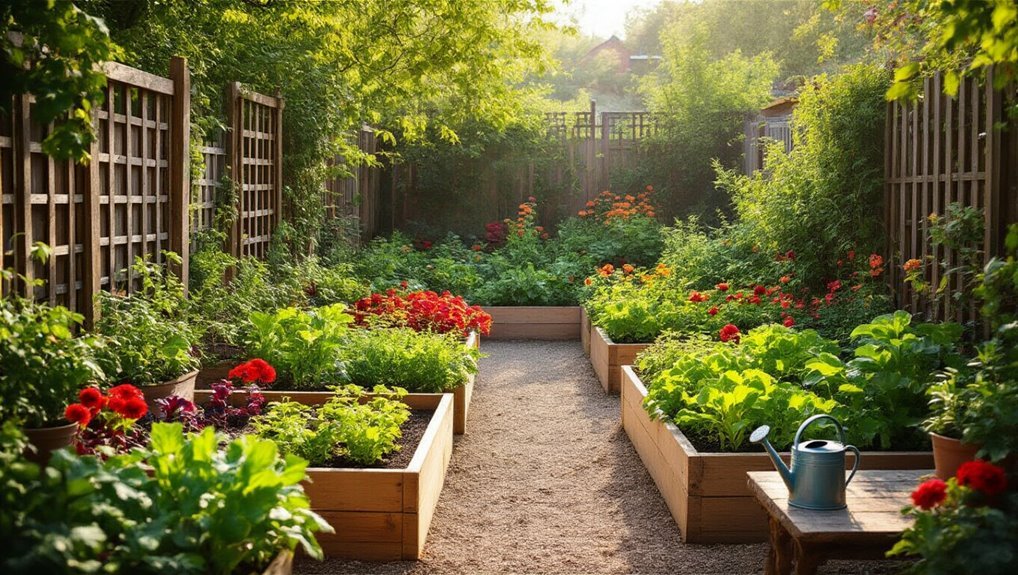
Maximizing your garden’s potential doesn’t stop with vertical gardening; implementing seasonal planting strategies can ensure you enjoy fresh produce year-round.
Start by planning your crops based on the growing seasons. For spring, plant cool-weather veggies like lettuce and radishes, while summer is perfect for tomatoes and peppers. Incorporating self-watering planters into your setup can help maintain consistent moisture levels and reduce daily maintenance for your garden beds.
In fall, switch to hearty greens and root vegetables. Don’t forget about winter; consider using cold frames or row covers to protect your plants.
Succession planting is vital, too. As soon as you harvest a crop, replace it with another suitable for the season. This method keeps your garden productive and vibrant throughout the year.
For early seed starting, using Seedling Heat Mats can help increase germination rates and encourage healthy seedling growth, giving your garden a head start each season.
Incorporating Edible Flowers Into Your Garden
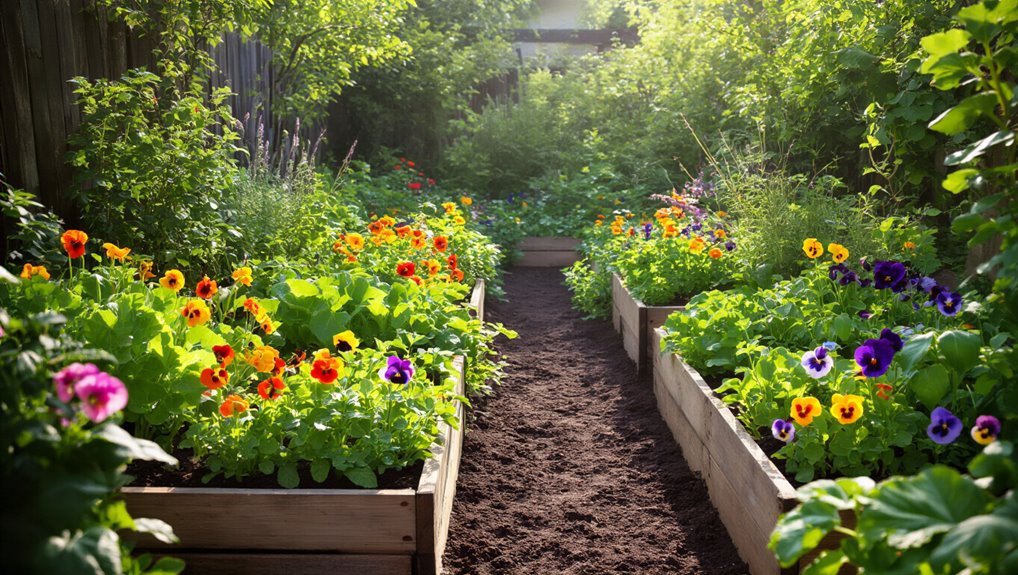
While many gardeners focus solely on vegetables and herbs, incorporating edible flowers into your garden can enhance both aesthetics and flavor.
These vibrant blooms not only beautify your space but also add unique tastes to your dishes. Using garden soil specifically formulated for healthy plant growth can make a significant difference in the success and vibrancy of your edible flowers. Here are four easy-to-grow edible flowers you should consider:
- Nasturtiums – Their peppery flavor adds a kick to salads.
- Calendula – With its bright petals, it offers a mildly spicy taste.
- Pansies – These colorful flowers have a sweet, grassy flavor perfect for garnishing.
- Chive Blossoms – They bring a subtle onion taste, great for dressings.
You can start your own collection by choosing from a variety of Edible Flower Seeds that are easy to grow and suited for both raised beds and planters.
Adding Decorative Elements to Your Raised Beds
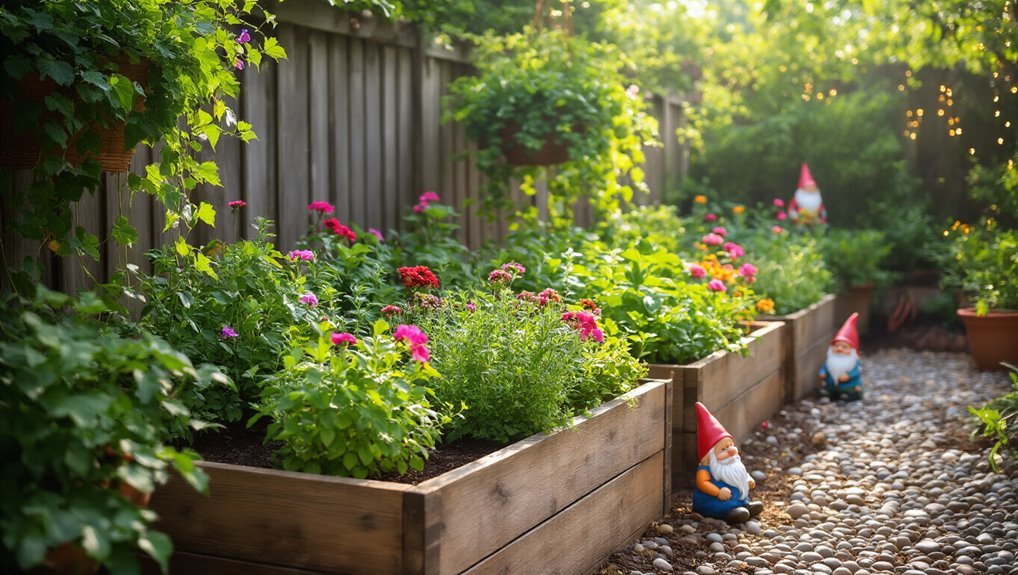
To create a visually appealing garden, adding decorative elements to your raised beds can transform them from simple planting areas into stunning focal points.
Consider using colorful pots or unique planters that complement your garden’s theme. You might also incorporate trellises adorned with climbing vines, adding height and texture. Garden stakes are another versatile option that can provide both style and support for growing plants.
Decorative gravel or mulch can enhance the visual appeal while suppressing weeds. Additionally, adding whimsical garden statues or fairy lights can bring a touch of charm and personality.
Don’t forget to think about your plant choices; vibrant flowers or lush foliage can serve as natural decor.
For an extra touch of style and functionality, consider placing Decorative Plant Stakes throughout your raised beds to enhance both beauty and plant support.
Sustainable Gardening Practices for a Greener Space
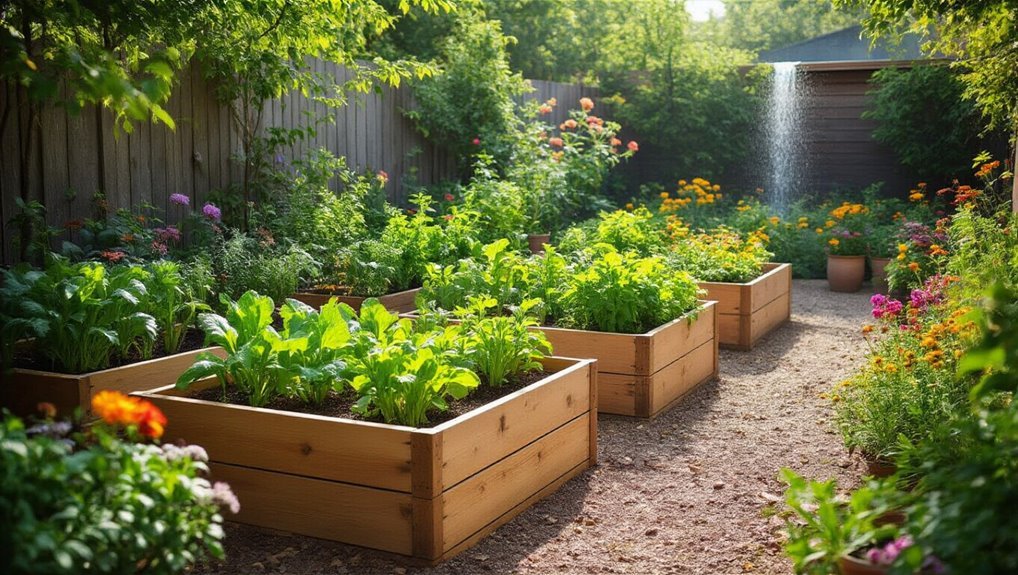
If you want to create a greener space, adopting sustainable gardening practices is essential. Not only do these practices benefit the environment, but they also help your garden thrive.
Here are four easy ways to get started:
- Compost: Use kitchen scraps and yard waste to create nutrient-rich compost, reducing landfill waste.
- Native Plants: Choose plants that are native to your area. They require less water and maintenance, and they support local wildlife.
- Rainwater Harvesting: Collect rainwater in barrels to irrigate your garden, conserving water and reducing your utility bills.
- Organic Pest Control: Use natural methods to manage pests, like introducing beneficial insects or using homemade sprays, to keep your garden chemical-free.
Tips for Maintaining Healthy Soil and Plants
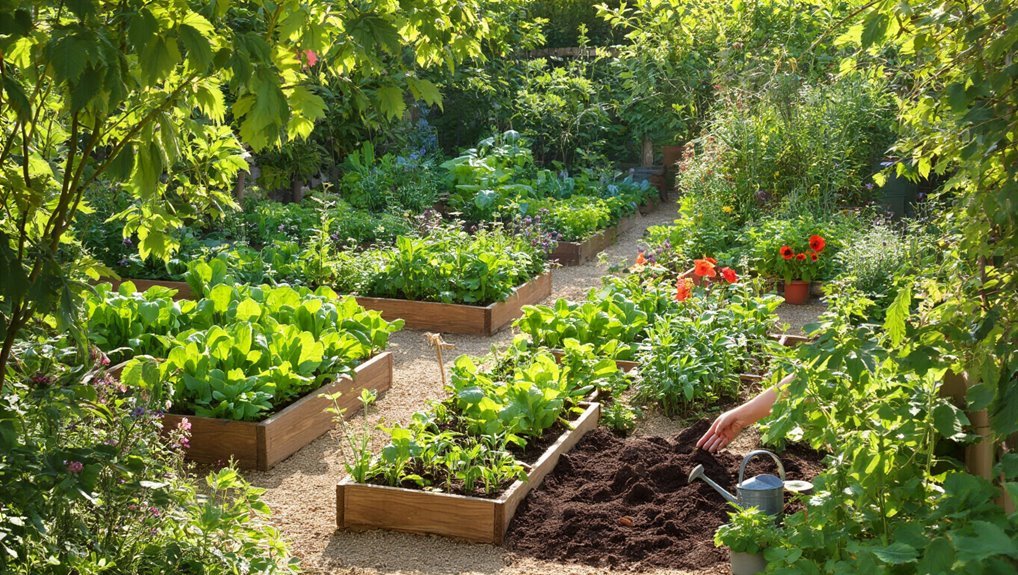
Maintaining healthy soil and plants is crucial for a thriving garden, as rich soil provides the nutrients your plants need to grow strong.
Start by testing your soil to understand its pH and nutrient levels. Amend it with organic compost or well-rotted manure to boost fertility.
Regularly check for pests and diseases; early detection makes treatment easier. Water your plants deeply but infrequently, encouraging deep root growth.
Mulching can help retain moisture and suppress weeds, while rotating crops each season prevents nutrient depletion.
Don’t forget to prune and deadhead your plants to promote airflow and encourage new growth.
Lastly, keep learning and adapting your care techniques to suit your specific plants’ needs for the best results in your garden.
Frequently Asked Questions
What Are the Benefits of Raised Beds Over Traditional Gardening?
Raised beds offer better drainage, improved soil quality, and easier access for planting and maintenance. You’ll find they warm up faster in spring, reduce weed growth, and can help extend your growing season significantly.
How Deep Should Raised Beds Be for Optimal Plant Growth?
Did you know that plants thrive better in at least 12 inches of soil? For optimal growth, aim for raised beds that are 12 to 18 inches deep. It helps roots explore and access nutrients efficiently.
Can I Use Recycled Materials for Building Raised Beds?
Absolutely, you can use recycled materials for building raised beds! Just ensure they’re safe and untreated. Old pallets, bricks, or even concrete blocks are great options, providing a sustainable and cost-effective way to create your garden.
How Do I Prevent Pests in My Raised Garden Beds?
You might think pests are inevitable, but you can take steps to prevent them. Use natural repellents, introduce beneficial insects, and maintain healthy soil. Regularly inspect your plants to catch any issues early.
What Are the Costs Associated With Building Raised Beds?
When considering costs for building raised beds, you’ll need to account for materials like wood, soil, and hardware. Labor may also factor in if you hire someone. Researching local prices helps you budget effectively.
Conclusion
In your backyard garden, raised beds and planters can bloom like a well-orchestrated symphony, each element playing its part to create harmony. By choosing the right location, materials, and design, you’re setting the stage for a thriving oasis. Embrace companion planting and edible flowers to enhance both beauty and flavor. Remember, sustainable practices and healthy soil are the backbone of your garden. With a little creativity and care, you’ll cultivate a vibrant space that flourishes year-round.
